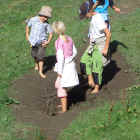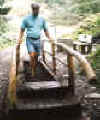| |
Wading through the mud is
especially favored by children, but maintenance of mud basins requires some effort on a
regular basis. Up to 20 kg (40 pd.) of loam per thousand visitors stick to the feet
and are in the worst case distributed over the rest of the trail and the subsequent
stations. It is recommended that mud basins should be followed by rinsing, perhaps wading
through a creek. Be also aware that muddy feet are slippery, and do not place a balancing
beam after a mud basin! If the barefoot trail belongs to a swimming pool, a shower should
be placed along the way.
|
enlargeable
thumbnails: |
| Mud puddle |
Sometimes the most
popular station of a barefoot park develops by itself as a puddle at the lowest point of
the path. It tends to grow in length, breadth, and especially depth, until some measures
need to be taken to prevent visitors from full-body bathing. |
 |
| |
It is not so much effort
to install a handrail at one or both sides and to replenish loam from time to time.
Otherwise the soup tends to get thinner and thinner. Depending on the weather, a natural mud puddle can either dry out or
become bottomless. Thus it is not the perfect solution of a well-attended barefoot park.
|
  |
| Loam basin |
In a bordered and
solid-based basin with a handrail in the middle (alternatively at both sides), a constant
quality of mud can be maintained. While the visitors are putting on pretty brown socks,
part of the material gets lost. Therefore about 20 kg (40 pd.) of loam must be
refilled per 1000 visitors. Water needs to be added during dry weather periods.
|
  |
| Peat footbath |
A wooden tub with
handrails offers a healthy peat footbath. |
 |
| |
Reducing risk of
vandalism with broken glass: On
solid surfaces, broken glass would be visible and easily removed, but putting the pieces
into the mud would be a truly malicious act. Therefore do not install barefoot park
stations in areas where persons apt for vandalism might spend their time!
In general, hard stony surfaces, on which bottles
could break accidentally, should not be placed near the mud basins. |
|





